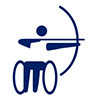 a Summer Games Paralympic Sport
a Summer Games Paralympic SportGoverning Bodies
International Governing Bodies

World Archery Federation
National Governing Bodies
United States

USA Archery
Introduction:
Para-archery is a sport of precision, concentration and strength open to all athletes with physical or cognitive impairments: any age, gender and ability. Athletes who may otherwise be dissuaded from participating in sports can participate in archery even alongside athletes without any disability.
There are three divisions in Para-Archery: Recurve Bow, Compound Bow and Visually Impaired. Within these divisions, athletes are classified by their impairment(s) as follows:
Competitors shoot arrows at a target marked with ten scoring zones, from a set distance. Para-archery is very similar to able-bodied archery. Athletes shoot the same rounds, distances and events. The distance from the target and number of arrows shot is the same for para-archery athletes as for able-bodied competitors except for the Visually Impaired (VI) division.
Para-athletes are divided into three functional classes (Standing, Wheelchair 1 and Wheelchair 2).
ARST (also known as ST).
Archery Standing. Athletes may compete standing or in a wheelchair, but have limited impairment.
ARW1 (also known as W1). Archery Wheelchair 1.
Impairment in the arms and legs. Athletes compete from a wheelchair and have “limited function in lower and upper limbs, and usually trunk eg those with high level spinal cord injuries, or high multiple limb amputations”.
ARW2 (also known as W2). Archery Wheelchair 2.
Impairment in the legs. Athletes compete from a wheelchair and have “significantly limited lower limb function with little or no upper limb impairment eg athletes with paraplegia, diplegia or double leg amputation below the knee.”
History of the Sport:
Para-archery has been contested at every Summer Paralympic Games since they were first held in 1960. Separate individual and team events are held for men and women. Only wheelchair classified athletes were eligible to compete at the 1960 Summer Paralympics in Rome in this sport. This continued at the 1964 Summer Paralympics in Tokyo and 1968 Summer Paralympics in Tel Aviv. Competitors with cerebral palsy classifications were allowed to compete at the Paralympics for the first time at the 1984 Summer Paralympics. At the 1992 Summer Paralympics, amputee and wheelchair disability types were eligible to participate, with classification being run through the IPC, with classification including standing, sitting and open. At the 2000 Summer Paralympics, 10 assessments were conducted at the Games. This resulted in 0 class changes. 88 male and 52 female para-archery athletes from across the world competed at the 2012 Summer Paralympic Games.
Rules – How to Play the Sport:
Athletes must have a current disability classification card for their results to qualify for World Records, titles or any other rankings, and assistive devices must be authorized by an international classifier and listed on the athlete’s classification card.
Assistive devices can include:
– Wheelchair
– Chair/Stool
– Block
– Permitted body support
– Prosthesis
– Release aid
– Bow bandage
– Bow arm splint
– String arm wrist splint
– Assistant
Visually impaired athletes in the VI division must wear a blindfold for vision impairment equality.


